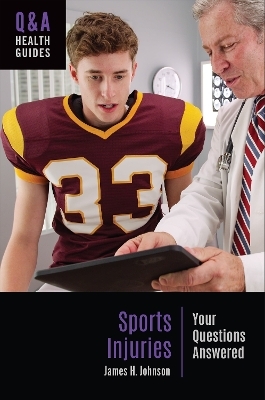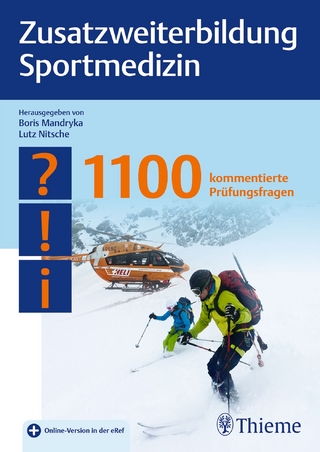
Sports Injuries
Greenwood Press (Verlag)
978-1-4408-7563-2 (ISBN)
Engaging in sports has numerous health benefits, but it's an unfortunate reality that it can also lead to injury. Some sports, such as football and cheerleading, are particularly notorious for causing harm to young athletes. Specializing in a particular sport or going too hard too fast can also lead to injury. But which injuries are most likely to occur, and how should they be treated in both the short- and long-term? When should an injured athelete consider surgery? When is it safe to get back in the game?
Books in Greenwood's Q&A Health Guides series follow a reader-friendly question-and-answer format that anticipates readers' needs and concerns. Prevalent myths and misconceptions are identified and dispelled, and a collection of case studies illustrate key concepts and issues through relatable stories and insightful recommendations. Each book also includes a section on health literacy, equipping teens and young adults with practical tools and strategies for finding, evaluating, and using credible sources of health information both on and off the internet—important skills that contribute to a lifetime of healthy decision-making.
James Johnson, PhD, is professor emeritus of Smith College in Northampton, MA. He is the co-author of Applied Sports Medicine for Coaches, along with a number of peer-reviewed articles in scientific journals.
Series Foreword
Acknowledgments
Introduction
Guide to Health Literacy
Common Misconceptions about Sport Injuries
Questions and Answers
The Basics
1. What are sport injuries?
2. How common are sport injuries, and who gets them?
3. What is the cost of sport injuries?
4. Can sport injuries have lifelong effects?
5. Are certain sports more or less likely to lead to injury?
6. Who is a weekend warrior? Why is being one a problem?
7. Does specializing in a sport increase the likelihood of injury?
8. What tissues of the body can be affected by a sport injury?
9. What are the basic stages of injury and healing, and how long do they last?
10. What is the difference between an acute injury and an overuse injury?
Common Sport Injuries
11. What is a muscle strain, and which muscles are most likely to be strained?
12. What is a sprain, and which ligaments are most commonly sprained?
13. What are tendonitis and tendinosis?
14. What is a fracture, and which bones are most likely to be fractured?
15. What are stress fractures, and who tends to get them?
16. What is a concussion, how do you get one, and what are the risks associated with an undiagnosed concussion?
17. What is the rotator cuff, and what happens when you injure it?
18. What other injuries can affect the shoulder?
19. What are the most common causes of pain in the elbow?
20. What are the most common problems with the back and trunk muscles?
21. What are the most common problems with the hip and thigh?
22. What are the most common injuries to the knee?
23. What are shin splints?
24. What are the most common injuries to the foot and ankle?
25. What is a heat illness?
Treating Sports Injuries
26. What is the typical therapy for different stages of healing for strains and sprains?
27. What is the typical treatment for an overuse injury?
28. What is the treatment for a concussion?
29. If you're injured while playing a school sport, how can an athletic trainer help with your injury? What about a strength and conditioning coach?
30. When should you see a physical therapist?
31. How do you select a physical therapist or a surgeon?
32. What are the most common surgeries to address sport injuries?
33. What if I continue to injure myself and need more surgeries?
34. Why is rehabilitation so important?
35. When can I return to participation?
Preventing Sport Injuries
36. Can sport injuries be prevented?
37. How do I start a fitness program without hurting myself?
38. What is energy system training?
39. How do you train to prevent overuse injuries while also improving performance?
40. What is overtraining syndrome, and how can I prevent it?
41. What's the best way to strength train, and how will this help prevent injury?
42. How flexible do I need to be? Should I do a lot of stretching before I play?
43. How can I minimize the chance of getting a concussion?
44. How do I reduce the frequency of shoulder and elbow injuries?
45. How should I train for a healthy back and core, and how will this help prevent injury?
46. How can I train to prevent hip and thigh injuries?
47. How do I stabilize my knee and reduce the frequency of knee injuries?
48. Are there specific ways to increase my ankle stability? What about ankle supports?
49. How can I prevent a heat illness?
50. How can I avoid common injuries while running, cycling, and skiing?
Case Studies
Glossary
Directory of Resources
Index
| Erscheinungsdatum | 26.10.2021 |
|---|---|
| Reihe/Serie | Q&A Health Guides |
| Sprache | englisch |
| Maße | 156 x 235 mm |
| Gewicht | 454 g |
| Themenwelt | Sachbuch/Ratgeber ► Gesundheit / Leben / Psychologie |
| Sachbuch/Ratgeber ► Sport | |
| Medizin / Pharmazie ► Medizinische Fachgebiete ► Sportmedizin | |
| ISBN-10 | 1-4408-7563-4 / 1440875634 |
| ISBN-13 | 978-1-4408-7563-2 / 9781440875632 |
| Zustand | Neuware |
| Haben Sie eine Frage zum Produkt? |
aus dem Bereich


